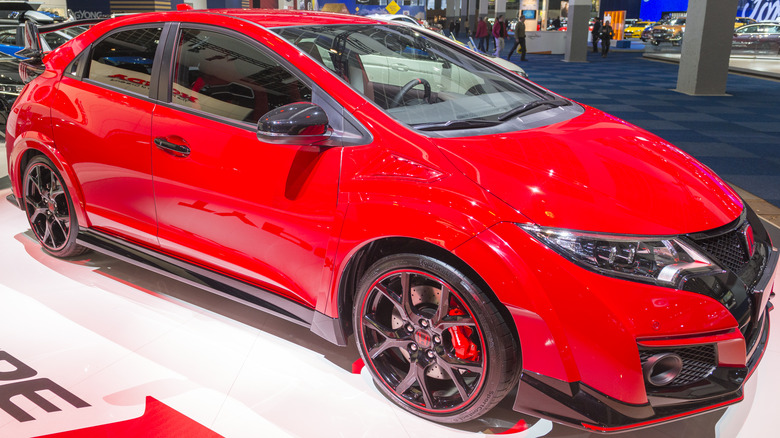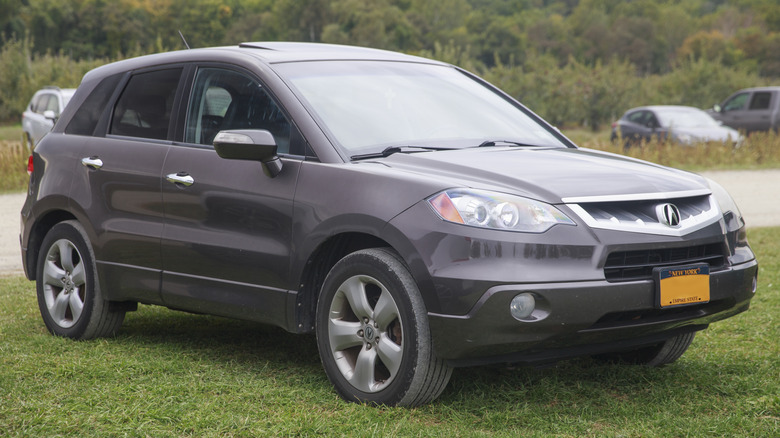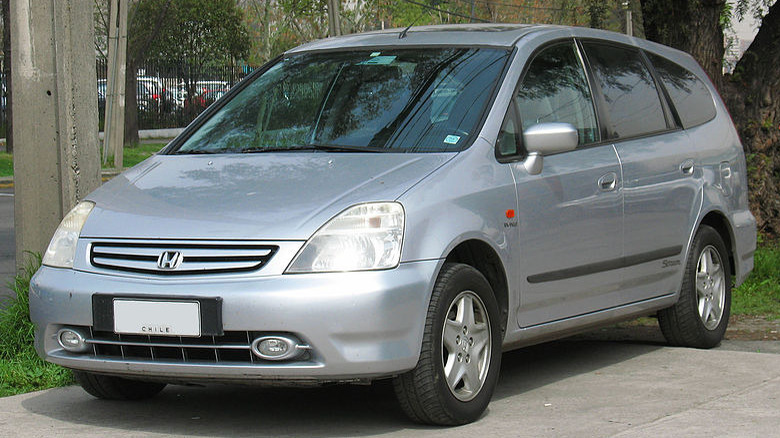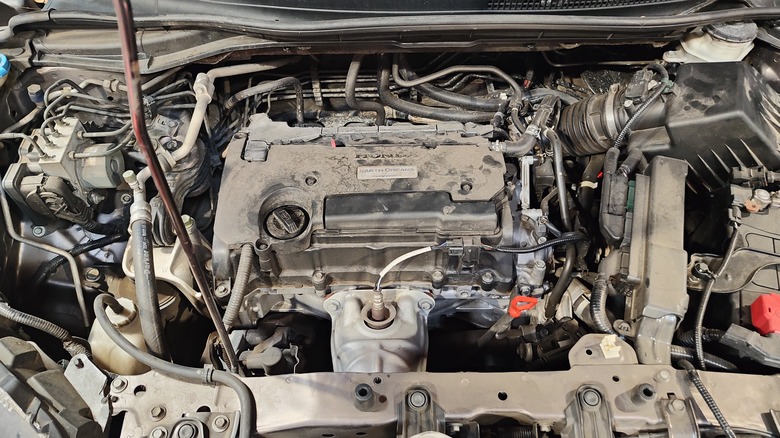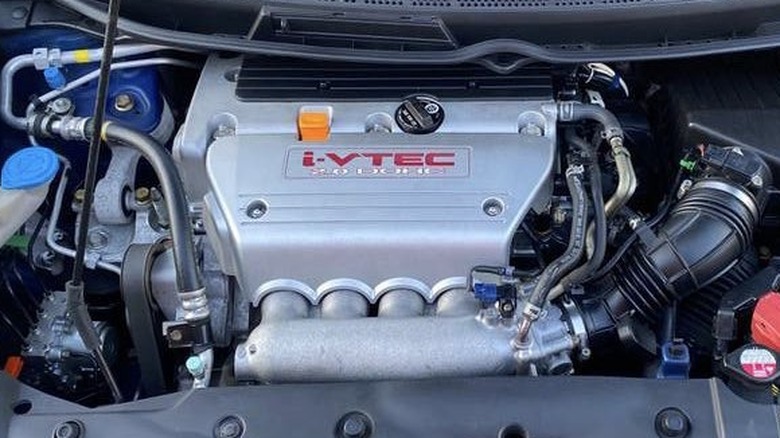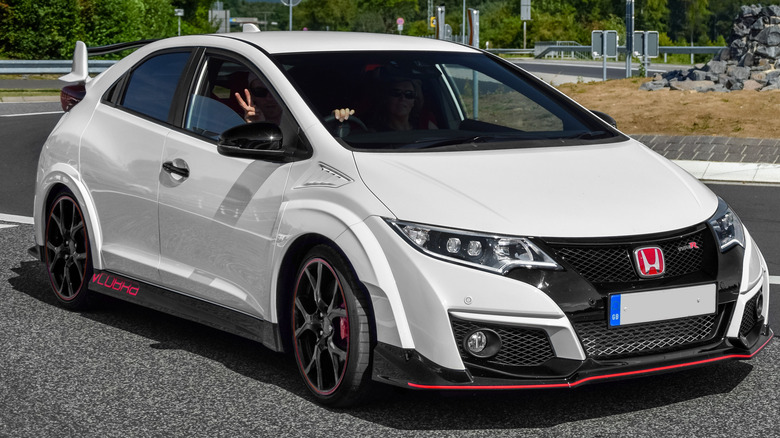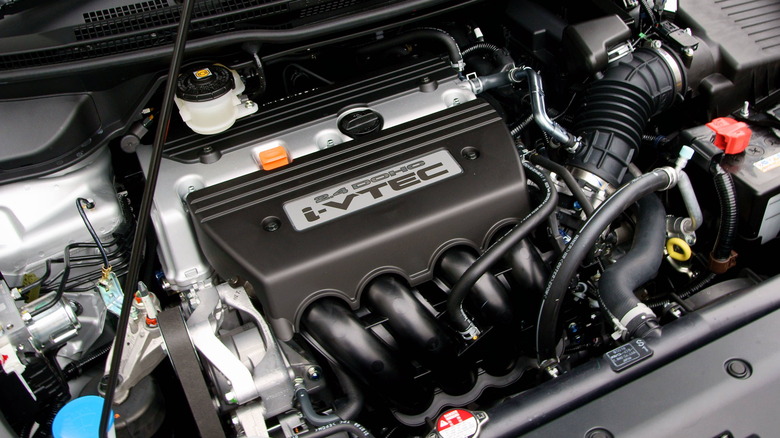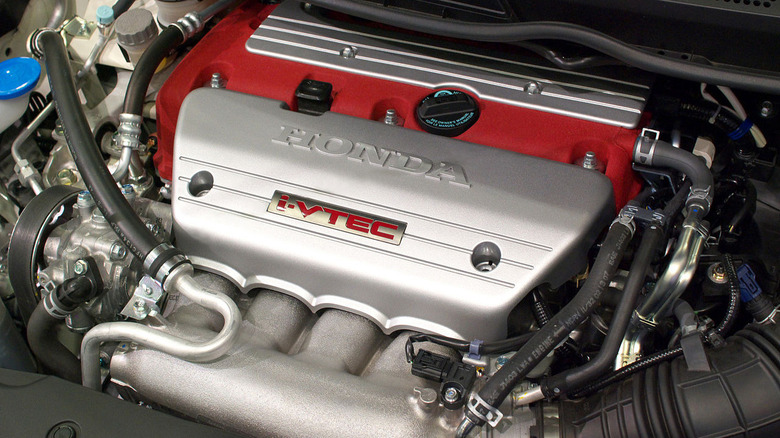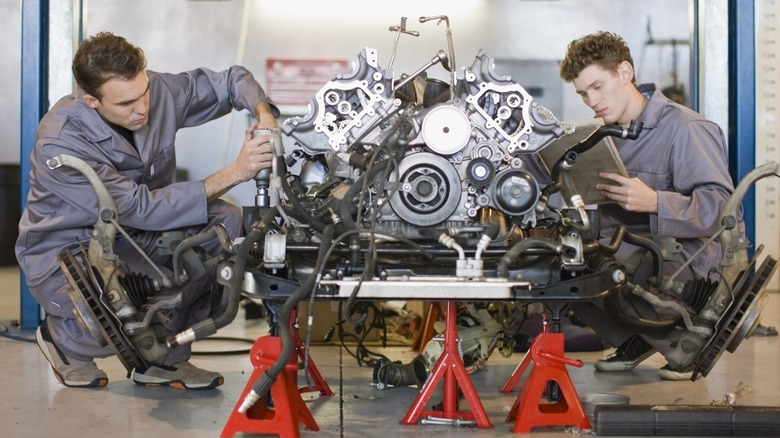Every Honda K-Series Engine Ranked From Worst To Best
The Honda Motor Company has served up some of the best sports cars of all time, and while Honda fans still fiercely debate the top spot, perhaps no engine is more cherished than the legendary K-series.
The K-series replaced the B-series, which had been Honda's primary four-cylinder double overhead cam engine (DOHC) since 1988. The B-series remains well-regarded, but there's no argument that the arrival of the K marked a new era.
There were options for more significant displacement, a cast-iron sleeved aluminum block, aluminum heads, and Variable Timing Control (VTC), which adjusted valve timing for optimal performance through the entire RPM range. Calling the K-series utilitarian is an understatement. The plucky four-banger powers everything from the Civic and Integra Type R to the family-friendly CRV.
Dropping in 2001, the K-series became the nerve center of a corporate conglomerate and a loyal and passionate modding community. But with several variations, we ask: which K motor is the pick of the litter? We take a holistic approach when rating the K-series from worst to best. It's not just about performance specs (though that's a factor) but what makes an engine great: availability, reliability, production runs, popularity, and accessibility all have a voice.
Which Honda K-series motors offer the most opportunity and versatility for your tuning and modding project? Dive into our list of every Honda K-series engine ranked from worst to best.
7. K23A
Calling a K-series the worst of anything is like calling out the worst pizza. Even bad pizza is good, but surrounded by its more distinguished brethren, SlashGear nominates the K23A as the worst of the line.
Six years into the K-series adventure, Honda wanted an engine that could smoothly pull around heavier cars, specifically the 2007 to 2012 Acura RDX with its heavy all-wheel drive system. Their solution was a 2.3-liter turbocharged four-cylinder K-motor making 240 horsepower and 260 lb-feet of torque. Sounds pretty good, right? After all, the K engine had been a beloved replacement for the B-series for years by this point. What's not to like about a turbo and some torque for towing the boat to the lake on weekends?
In reality, drivers found the power delivery of the K23 to be spotty, the factory turbo uninspiring, and the automatic of 5-and 6- speed transmissions to which it was mated milquetoast. Combined with poor gas mileage outside of testing situations, the life span of the K23 was relatively short, which means mixing and matching aftermarket parts is challenging for anyone with ideas about a K23A-powered build. Honda knew what they had; unlike other K-series engines, they preferred to scrap it rather than develop it.
The K23 is the only 2.3-liter K-series, suffers from limited production and poor performance, and turns up as the worst K-series engine to tinker with on our list.
6. K20b
The K20B has a less stellar career than some of its colleagues in the K-series family. The only vehicle to ever get a K20B engine was the Honda Stream Absolute, a Civic-based passenger vehicle meant to drive like a sedan while providing a larger vehicle's space and capacity. The Honda Stream was a European and JDM exclusive for several years. It got a short-lived K-series treatment between 2004 and 2006. The name of the K20B mission is balance — K enthusiasts won't find high-revving performance with the B.
The K20B is vanilla, designed to be what it ended up as a grocery-getter. With 156 horsepower and 139 lb-feet of torque, its limited production makes it one of the least talked about K-series engines. But as a K20, it still gets some love from the modding community, though there are plenty of better options further down. After all, who wants a mini-van engine in their fire-breathing street killer?
If you're dying to slam a 2.0-liter K-series into your ride, the K20B might be an option if you're willing to tear it down and build it back up as it deserves, but the other 2.0-liter Ks have a lot more to offer as a base performance engine before getting to the B. A limited production run, low-performance numbers, and better options mark the K20B as one of Honda's least impressive K-series offerings.
5. K24Z/W
The Honda K24 is the largest K-series engine in terms of displacement, offering an after 400 cubic centimeters by boring and stroking the top end of the same short block used in the K20. When the K24Z and K24W rolled around, Honda had already been producing the 2.4-liter option for six years. Is this later-generation K24 even meatier than the original?
Not from a performance standpoint. With six years of K24 success, Honda updated its popular 2.4-liter engine in 2007 in the hopes of melding what made the K24A a success with more environmentally friendly performance. By then, Honda had developed the K24A8, which was converted into the Z with emission-conscious changes to the catalytic converter. The Z1 made 166 horsepower for the 2007 to 2009 CRV. The K24Z2 boosted that horsepower to 177 for service in the 2008-2012 Accord LX, while the Z3 introduced a new cylinder head and exhaust manifold into an engine that put out 190 horsepower and 162 lb-feet of torque, pushed up to 201 horsepower and 172 lb-ft of torque for the high-performance Acura TSX and Accord CP2 and CS1.
Future iterations of the K24Z/W were geared primarily toward meeting ever-stricter environmental standards. Though not ordinarily conducive to performance, Honda did an admirable job continuing to squeeze as much power as it could out of the K24Z/W. Still, for tuners who want the larger displacement option, scroll on for variations focusing more on performance and less on government regulation.
4. K20Z
Think of the K20Z as the updated version of the original 2.0 liter K20. Now, take everything good about the A and use the benefit of experience and years of development, and you arrive at the K20Z series.
Honda produced the Z1 in 2005 and 2006 — a relatively limited run compared to some of the other motors on this list. Fans of the K20Z1 cited its new exhaust manifold, performance camshafts, and an 11:1 compression ratio as benefits that set it above the A2. The K20Z2 debuted in 2006 as an upgrade to the K20A1. It introduced updated camshafts and a controversial throttle-by-wire that many K fans found galling, preferring the crisp response of mechanical throttle body performance.
Of the Z engines, the K20Z3 got the longest production run between 2007 and 2015, building on what the K20Z1 began and improving on the intake manifold in addition to the K20Z1 exhaust manifold and using variable valve timing on the intake side. The result is 197 horsepower at 7,800 RPM and 142 lb-feet of torque. Undoubtedly, the K20Z3 updates what Honda learned with the K20A series, providing respectable modification options. However, a high 11 compression ratio makes the Z3 an expensive engine to turbocharge as a safe tuner will need to tear it down and build it to handle the boost.
3. K20C
The K20C may be the current king of the K-series engines. If the K20Z is the updated K20A, the C takes it to the next level. Introduced in 2015, three of the four 2.0 liter K20C engine variants come turbo-charged, and they are the current powerplants of the Type R series. The K20C1 arrived in 2015 sporting upgrades that included an improved lightweight crankshaft, beefed-up piston rods, and a new cylinder head, amongst other improvements. The turbo provided 23 pounds of boost and would push the horsepower to over 300, making it the most powerful of the K-series 2.0-liter engines.
The C1 was reserved for use in Europe, and keeping in tradition, Honda toned down the C2 for use in less aggressive models. This engine has been powering the Honda Civic Type R since 2015. Most K-nuts would love to get their hands on the C series. It's the pinnacle of Honda's 2.0-liter production engines and incorporates everything they've learned in 20 years of building K-motors.
So why isn't the K20C at the top of the list? Well, it's the pinnacle, and it remains in high demand for good reason, but modders may struggle to get their hands on one. The cars sporting the engine currently cost upwards of $50,000 and remain relatively new, meaning wrecked ones will be harder to find and more expensive on the aftermarket. The K20C1 is an excellent and powerful motor, taking the third spot on this list.
2. K24A
There's no replacement for displacement, and the K24 is the largest K-series engine available, with 2.4 liters of boom room. One the most modified and adaptable of the Ks, the 24 has powered vehicles as diverse as the Acura TSX, the Honda Accord, the Honda Odyssey, and the Honda Element.
The K24 dropped in 2002, just a year after the K20 arrived. Based on the same short block, Honda bored and stroked the K24A to achieve the additional 400 cubic centimeters of displacement, and they haven't looked back since. The K24A high-performance iteration produced as much as 206 horsepower for the 2015 to 2020 Acura TLX. It doesn't sound like much, especially compared to the K20C, but what makes the K24 interesting is it can support a turbo-charged boost to between 400 and 500 horsepower without messing around with engine internals. That sound was modders' jaws dropping around the country.
For a tuner or modder looking to tuck Honda's biggest K-series engine under their hood, the K24A is at the top of the list. In production just one year after the K20. The 24 has seen nearly a quarter-century of development, comes in several flavors, and has vast modification potential to be a great engine for projects. The big boy of the K-series engines has much to offer, and it takes second place on our ranking of the legendary K.
1. K20A
Sometimes the OG stays on top of the pile. The inaugural K20 motor might not have the most stock horsepower or the largest displacement, but when it comes to availability, versatility, popularity, and accessibility, the original remains the favorite of Honda fans around the world. From 2000 to 2011, the K20A came in several variations, producing power ranging between 155 and 220 horsepower and between 132 to 152 lb-feet of torque, depending on the year and variant.
Honda pushed out several variations of the K20A, unimaginatively named the K20A1, K20A2, K20A3, K20A4, and K20A6. The A1 was purely for the Japanese domestic market (JDM). The K20A2 first arrived in the United States under the hoods of Honda's performance sedans, such as the Integra Type R, Civic Type R, and Acura RSX. The K20A2 pushed 200 horsepower for the second generation Civic Type R between 2001 and 2006. The A3 variant might sound new and improved, but Honda downgraded the internals for cheaper production. The A3 and A4 are defanged versions intended for Honda's more sedate Accord and CR-V. The A3 is good for about 160 horsepower and 141 lb-feet of torque, while the A4 is rated at 150 horsepower with 140 lb-ft of torque.
The K20A and its variants provide a mix of reliability, modification potential, power, accessibility, and availability not found with any other engine on this list, making the classic K20A top dog on our list of Honda K-series engines ranked from worst to best.
Our Rankings
The K-series engine had big shoes to fill, coming on the heels of the beloved B-series. The engines have performed admirably over the past quarter century; as far as the four-cylinder engines are concerned, they cover every aspect, from efficient fuel savers to wound-up street machines.
There is also a K-series for everyone. Need a replacement for your mini-van? Check out the K20b. Want a certified screamer with modern technology? The K20C is for you. We took a holistic approach to ranking these engines, but much depends on the individual consumer's needs. With the K-series being a favorite for tuners and tinkerers worldwide, we evaluated them based not just on any single performance or reliability metric but on a holistic scale based on accessibility, availability, reliability, power specs, and tunability.
People's needs vary by application, but our list of Honda K-series engines ranked worst to best will get you on your way to choosing the best "K" to drop into your engine bay.
